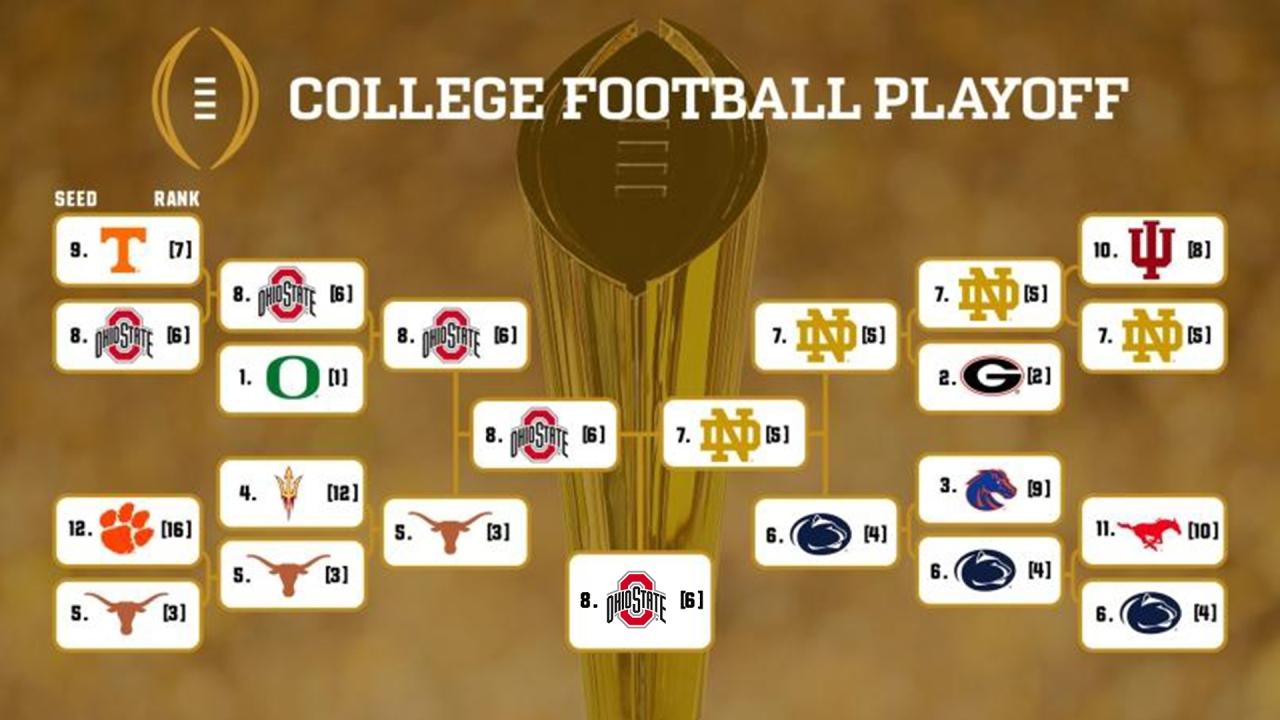In the long and storied history of college football, few programs command the respect, tradition, and pageantry that Ohio State University does. From the days of Woody Hayes to Urban Meyer and beyond, the Buckeyes have remained a constant national powerhouse, producing elite talent and contending for championships on an annual basis. But in recent years, Ohio State has achieved something no other school can claim: it won both the first-ever four-team College Football Playoff in 2014 and the inaugural twelve-team College Football Playoff in 2024. These two landmark victories, separated by a decade but tied by a shared ethos of excellence and resolve, have cemented Ohio State’s place not just in the annals of greatness, but at the very summit of college football’s evolving narrative.
When the College Football Playoff replaced the BCS in 2014, the sport entered a new era. No longer would computer rankings and voter algorithms alone decide who would play for a national title. Instead, the four best teams, as determined by a selection committee, would settle matters on the field. In that inaugural year, few gave Ohio State much of a chance. The Buckeyes had lost their star quarterback Braxton Miller to injury in the preseason. His backup, J.T. Barrett, carried the team through most of the season before going down with a broken ankle in the final regular-season game against Michigan. That left Cardale Jones, a third-string quarterback with a rocket arm and limited experience, to steer the ship in the Big Ten Championship Game and, if all went well, beyond.
What unfolded over the next three games was nothing short of legendary. Ohio State demolished Wisconsin 59-0 in the Big Ten title game, a victory so convincing it vaulted them past Baylor and TCU into the fourth and final playoff spot. Then came Alabama, the juggernaut. Most pundits wrote off the Buckeyes in the Sugar Bowl semifinal, assuming Nick Saban’s Crimson Tide would roll over an injury-riddled Ohio State. Instead, Jones played like a veteran, Ezekiel Elliott ran like a man possessed, and the Buckeye defense stood firm. Ohio State shocked Alabama 42-35, punching their ticket to the title game.
There, they met Oregon, led by Heisman winner Marcus Mariota. Yet again, the Buckeyes were underdogs. And yet again, they triumphed. Elliott rushed for 246 yards and four touchdowns, Jones commanded the offense with poise, and the defense swarmed. Ohio State walked away 42-20 winners, national champions of the first-ever College Football Playoff. It was an underdog story for the ages—one defined by adversity, resilience, and undeniable talent. The victory solidified Urban Meyer’s legacy and restored Ohio State’s place atop the college football mountain.
Fast forward ten years to 2024, and college football found itself at another crossroads. The playoff expanded from four to twelve teams, a move designed to include more programs, reduce regional bias, and bring a broader spectrum of fanbases into the championship chase. It was a shift driven by both competitive balance and financial interests, but it promised more drama, more unpredictability, and more opportunities for greatness. For traditional powerhouses like Ohio State, it meant that the path to the title was longer, more grueling, and filled with traps. But for the Buckeyes, who had come close many times since 2014 without reclaiming the crown, it also represented a golden chance to finish what past teams had started.
The 2024 season was vintage Ohio State in many ways: a dominant defense, explosive offensive playmakers, and a team that rarely flinched in big moments. Still, they entered the playoff as the No. 5 seed, meaning they would not receive a first-round bye. Instead, they’d have to navigate four tough games to hoist the trophy once more. The first test came against Tulane, a scrappy Group of Five champion that had stunned several Power Five opponents that season. The Buckeyes took care of business with a disciplined performance, leaning on their ground game and shutting down Tulane’s spread offense.
Next came a quarterfinal clash against the SEC’s runner-up, LSU, a team known for speed and swagger. It was a clash of titans, a game that went back and forth for four quarters. Ohio State’s defense bent but didn’t break, and a late touchdown drive, capped by a 37-yard scramble by their dual-threat quarterback, sealed the win. In the semifinal, the Buckeyes faced Michigan—their archrival. Never before had The Game occurred on such a grand stage. The stakes were immense. The intensity was electric. And for the third time in the season, the teams collided in what many are calling the greatest trilogy in college football history. Ohio State edged out Michigan in double overtime, exacting revenge for a regular-season loss and advancing to the championship.
Waiting in the title game was the No. 1 seed, Texas. The Longhorns, rejuvenated under a new coaching regime, had bulldozed their way through the playoff, and many believed it was their year. But as in 2014, Ohio State saved its best for last. Their defense, fast and physical, stymied Texas’ high-powered offense. Their offense, balanced and unrelenting, struck again and again. When the final whistle blew, the scoreboard read 38-24 in favor of the Buckeyes. Once more, Ohio State had reached the pinnacle, this time conquering the first twelve-team playoff with the same vigor and poise they’d shown a decade prior.
To win two national championships is rare. To win two in such distinct and historically significant playoff formats is unprecedented. The duality of those triumphs speaks volumes about the culture within Ohio State’s football program. It shows an adaptability that few programs possess—one capable of thriving under radically different circumstances. The 2014 team was a gritty, next-man-up squad that overcame injuries and expectations. The 2024 team was deep, experienced, and battle-tested, having run the gauntlet of a longer playoff with an iron will. Together, they tell the story of a program that evolves, reloads, and never relents.
Beyond the championships themselves lies the broader impact of Ohio State’s twin feats. By winning the first four-team and twelve-team playoffs, the Buckeyes have effectively bookmarked a transformative era in college football. They were there when the sport shifted from controversy-laden polls and computer models to a modern, equitable playoff system. And they were there again when that system expanded to embrace inclusivity and spectacle on an even grander scale. Ohio State wasn’t just present; it was dominant. These wins will forever serve as reference points in the ongoing dialogue about what greatness looks like in college football’s most defining moments.
For the fan base, the legacy is rich. Buckeye Nation has always been one of the most passionate in the sport. From the Horseshoe to road games across the country, Ohio State fans travel well, cheer loud, and demand excellence. These championships reward that loyalty. They validate the support, the expectations, and the unwavering belief that their team could always return to the summit. Young fans who were in middle school during the 2014 triumph are now college graduates, watching the 2024 victory with a new appreciation. Alumni, parents, and students alike are linked forever by these generational moments.
In the broader scope of college football history, Ohio State now stands even taller. The Buckeyes were already among the winningest programs in the sport, with a lineage that includes Heisman winners, Hall of Famers, and national championships. But these two playoff-era titles elevate them into a unique category. Only a handful of schools—Alabama, Clemson, Georgia—have had playoff-era dynasties. Yet none can claim bookending the beginning and the evolution of the format with national championships. Ohio State, in this sense, isn’t just great. It’s foundational.
As college football continues to evolve—with the potential for further playoff expansion, conference realignment, and NIL-fueled transformations—Ohio State remains a beacon. It is a program built to withstand change, built to win regardless of format or foe. Its infrastructure, recruiting, coaching, and institutional support are all engineered for sustained success. And its history, already glimmering, now has two radiant new jewels that define an era.
In 2014, the Buckeyes shocked the world with a third-string quarterback and a storybook run. In 2024, they confirmed their dominance through grit, talent, and championship pedigree in a deeper, more rigorous playoff. The sport changed, but the result stayed the same: Ohio State, champions once more. From the first playoff to the next generation, the Buckeyes have made history—again—and in doing so, they’ve left a mark on college football that time will never erase.



